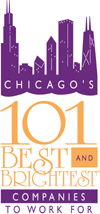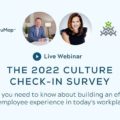What are you doing with Employee Survey Results?
I had the fortune to attend a fabulous educational session at yesterday’s 7th Annual Awards Symposium for Chicago’s 101 Best and Brightest Companies to Work For. While seeking employee input is a best practice for organizations looking to improve engagement, neglecting feedback puts the organization on the fast track to decreased morale, frustration and broken trust.
The session described herein was titled, “What are you doing with Employee Survey Results? Are you effectively using employee input? The panel discussion was successfully moderated by Ms. Lauren Soderstrom, HR Training Specialist with The Management Association of Illinois. Lauren did a great job of bringing two very different organizations to the table. Panelist, Ms. Lauren Navratil, HR Manager representing 101 Best and Brightest Companies to Work For in Chicago three-year consecutive winner Bel Brands, USA and Mr. Jerry Hix, Board Member of the Bolingbrook Park District.
One for profit, another operating as a non-profit . Yet, it is important to note that throughout the session it became increasingly apparent that both had used similar though varied approaches to engage their workforce in a collaborative way. Equal weighting was given to perceived “engaged” employees as well as least “engaged” employees. They launched survey initiatives to go to the source. Jerry made a point to share that it is “commendable when your workforce has heart and the culture out front is one thing but it is what is behind the scenes that can often reveal a different picture.” Both organizations wanted to extend a hand out as many of us know the realities of what happens over time if leadership fails to do so.
It was refreshing to attend a session where both panelists truly understood the value of sharing their experience candidly. I am confident that every attendee took a tid bit away. First, Why? Lauren’s organization approached the engagement process proactively essentially building from the ground up. Engagement surveys are among the most effective ways to gauge employee satisfaction. Anyone seeking to reduce turnover, retain talent or increase the level of productivity within your organization, the first step is to assess the level of employee engagement and the factors that contribute to, or detract from, employee engagement within your organization. The premise for Bel Brands, Inc. was that one cannot create value added programs without first identifying what the workforce itself values. As Lauren expressed, “The whole process was more about, how do we engage you?”
In contrast, Jerry had explained the survey and engagement process for Bolingbrook Park District had been more reactive than proactive in nature. The Board had elected to source an external resource to administer and take them through the survey process. A decision meant to maintain anonymity. The summary results for internal use were desired to protect any fear of retaliation. Something every HR professional understands. This organization has a large section of part-time employees and thus there was careful consideration given to what segments of the employee population would be surveyed. Results were obtained and focus groups were held. While the results provided one picture, he made it known that it was the qualitative feedback that revealed the real issues.
Both organizations came across common themes ranging from communication issues, overall transparency, and the ever-present topic of work life balance. The district used a structured approach focusing in five areas: Management Effectiveness, Recognition & Rewards, Compensation/Benefits, Communication, and then Productivity/Quality. The workforce was so eager to engage the process they had to limit every participant to two focus groups. A great concept and something to note, especially in driving engagement beyond the initial front-runners. Jerry had noted that any eager employees were thanked for the participation and then encouraged to recruit another.
Both panelists expressed the management’s commitment to address the feedback and initiatives were derived. Some initiatives required team assignments (Task/Time/Resource). To avoid any politics for lack of a better word, each employee that takes on ownership of budget and/or task becomes the presenter. Presentations were made quarterly as to the progress and results. Only actions that had become obsolete had fallen off. Jerry had a philosophy that “We can do what we want but we must prioritize because you can’t do it all”. Each panelist was asked for their advice.
Jerry exclaimed, “Be patient but be demanding and commit to succeed!” and the benefits for both organizations today include more smiles and more team collaboration when facing daily issues. Lauren shared that the cross functional information allowed people to generate a better perspective across the organization. All good things but only because they both championed what Jerry summed up as “we should all be eager to hear the yucky stuff!”
When asked how to institutionalize engagement without losing the energy of the first round of surveys, Lauren shared the importance of incorporating feedback into the culture. She shared the value of finding an engagement tool that works and then use that same tool to measure change and impact. Lauren emphasized the importance of having a culture in place that provides for candid feedback when even confronting random impacts on culture, in her case an office relocation. Open communication throughout the process even when the desired initiative or policy change is not feasible is key. Lauren expressed the importance of taking time to hear the workforce. She explained, “We heard what they wanted and even if I could not provide it now, I did not neglect it. Acknowledging we heard and explaining what prevented us from making any changes helps the employees know we heard them.”
Thank you to Lauren Soderstrom, Lauren Navartil and Jerry Hix for a value added contribution to this year’s Awards Symposium.
It is the intent of 101 Best and Brightest Companies to Work For to encourage each of you to make a positive difference in your workplace through more personal interaction and recognition of your most valuable assets. 101 Best and Brightest Companies to Work For provides individualized single assessments of HR Surveys and Employee Engagement Surveys. Summary Statistics can be purchased to reveal both regional external benchmarks as well as internal indicators for Engagement. If you would like to learn more about our educational sessions and/or engagement tools made available throughout the year, please do not hesitate to contact me to learn more. ~






